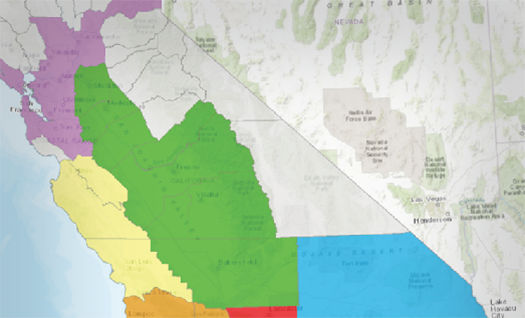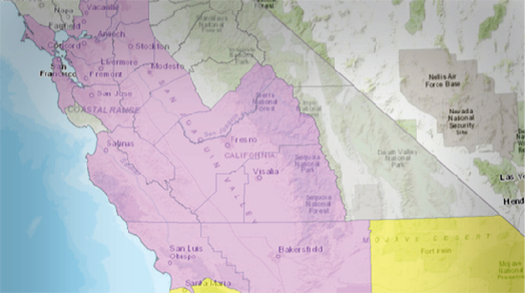Asian Citrus Psyllid (ACP) Compliance
Introduction
The Asian citrus psyllid (ACP) is a pest that acts as a vector (carrier) spreading “huanglongbing” (HLB), a devastating disease of citrus trees. This bacterial disease is transmitted to healthy trees by the psyllid after it feeds on infected plant tissue. There is currently no cure for infected trees, and the tree will eventually die.
ACP can be transported with bulk citrus from one location to another. The California Department of Food and Agriculture (CDFA) established a quarantine on bulk citrus. Movement of bulk citrus is only allowed under special permit and facilitated by a signed compliance agreement. Bulk citrus regional quarantine zones were established and are designed to mitigate the risk of moving ACP host material.
There are seven bulk citrus regional quarantine zones. Fresno County and other Central Valley counties are in Regional Quarantine Zone 2. There are restrictions on moving bulk citrus from or within regional quarantine zones.
The requirements for moving bulk citrus within Zone 2 are:
- The transporting vehicle must be fully enclosed or completely covered (tarped); and
- All parties (grower/grove manager, hauler/transporter, packer/processor) involved must be under compliance agreement.
More information on moving bulk citrus from or to other bulk citrus regional quarantine zones
ACP Bulk Citrus Compliance
When transported, bulk citrus must always be in a fully enclosed vehicle or completely covered with a solid or mesh tarp!
ACP Bulk Citrus Compliance Agreement
The compliance agreements contain regulatory requirements for bulk citrus. The following individuals will need an ACP Bulk Citrus Compliance agreement.
- Citrus Grower/Grove Manager
- Bulk Citrus Transporter/Hauler
- Citrus Packer/Processor
- Citrus Fruit Sellers (citrus sold at farmers markets, flea markets, or swap meets)
Related Links
Note: ACP Bulk Citrus compliance agreements can be obtained from our Main Office and District Offices.
ACP Bulk Citrus Quarantine Zones
 Bulk Citrus Regional Quarantine Zone 1 comprises un-infested counties where HLB has not been detected, there are no contiguous citrus growing regions, and it is not proximate to the border with Mexico.
Bulk Citrus Regional Quarantine Zone 1 comprises un-infested counties where HLB has not been detected, there are no contiguous citrus growing regions, and it is not proximate to the border with Mexico.
Bulk Citrus Regional Quarantine Zone 2 comprises counties such as Fresno and other central valley counties that are partially infested with ACP, HLB has not been detected, a geographical barrier exists between it and adjacent citrus growing regions (i.e., Zones 4, 5, and 6), a citrus growing region exists within the zone, sufficient citrus commodity cleaning and packing capacity exists within the zone, and geographical barriers separate it from zones that are generally infested with ACP and where HLB has been detected (i.e., Zone 6).
Bulk Citrus Regional Quarantine Zone 3 comprises counties that are partially infested with ACP, HLB has not been detected, a geographical barrier exists between it and adjacent citrus growing regions (i.e., Zones 2 and 4), a citrus growing region exists within the zone, sufficient citrus commodity cleaning and packing capacity exists within the zone, and geographical barriers separate it from zones that are generally infested with ACP (i.e., Zone 4) or where HLB has been detected (i.e., Zone 6).
Bulk Citrus Regional Quarantine Zone 4 comprises counties that are generally infested with ACP, HLB has not been detected, a geographical barrier exists between it and adjacent citrus growing regions (i.e., Zones 2 and 3), a citrus growing region exists within the zone, sufficient citrus commodity cleaning and packing capacity exists within the zone, geographical barriers separate it from Zone 6 where HLB has been detected, and it is not proximate to the border with Mexico.
Bulk Citrus Regional Quarantine Zone 5 comprises counties that are generally infested with ACP, HLB has not been detected, a geographical barrier exists between it and adjacent citrus growing regions (i.e., Zones 4 and 6), a citrus growing region exists within the zone, sufficient citrus commodity cleaning and packing capacity exists within the zone, a geographical barrier separates it from Zone 6 where HLB has been detected, and it is proximate to the border with Mexico.
Bulk Citrus Regional Quarantine Zone 6 comprises counties, or portions of counties, that are generally infested with ACP, HLB has been detected in some areas, a geographical barrier exists between it and adjacent citrus growing regions (i.e., Zones 2, 4, and 5), a citrus growing region exists within the zone, sufficient citrus commodity cleaning and packing capacity exists within the zone, and it is not proximate to the border with Mexico.
Bulk Citrus Regional Quarantine Zone 7 comprises counties that are partially infested with ACP, HLB has not been detected, there are no contiguous citrus growing regions, and it is not proximate to the border with Mexico.
ACP Nursery Compliance
 Nursery Stock Regional Quarantine Zones
Nursery Stock Regional Quarantine Zones
Citrus Nursery Stock Cleanliness Program Nursery Stock Regional Quarantine Zones are designed to restrict and mitigate the risk associated with the movement of Asian citrus psyllid host material. There are three Nursery Stock Regional Quarantine Zones.
Nursery Stock Regional Quarantine Zone 1 comprises un-infested counties, geographical barriers exist between it and Zone 3, and it is not proximate to the border with Mexico.
Nursery Stock Regional Quarantine Zone 2 comprises counties that are partially infested with ACP, geographical barriers exist between it and Zone 3, HLB has not been detected, and the zone is not proximate to the border with Mexico.
Nursery Stock Regional Quarantine Zone 3 comprises counties that are generally infested with ACP, HLB has been detected in some areas, and the zone is proximate to the border with Mexico. For questions or information regarding any of the following or to request a compliance agreement or permit, please contact CDFA Pest Exclusion at peinfo@cdfa.ca.gov or call 916-654-0312.
Compliance Agreements
- Exhibit ACP-NS1: Nursery Stock Grown in an Exclusionary Facility/Screenhouse
- Exhibit ACP-NS: Exhibit ACP-NS: Nursery Stock (Interstate Movement)
- Exhibit ACP-NP: Production Nursery Stock Approved Treatments for ACP
- Exhibit ACP-M: Farmers’ Market and Swap Meet Nursery Stock Vendor
Related Links
Citrus Nursery Stock Cleanliness Program
Participation in the Citrus Nursery Stock Cleanliness Program is mandatory for any person who produces any citrus propagative material, including seed. All citrus propagative materials must be obtained from source trees registered with this program or from the Citrus Clonal Protection Program at UC Riverside.
Requirements for Interstate Movement from a Federally Approved Screen House (Federal Order)
Exclusionary facilities can be approved either inside or outside of an ACP quarantine area after the nursery is issued a compliance agreement.